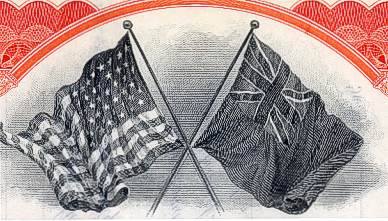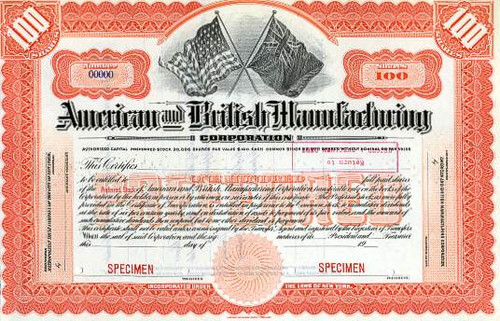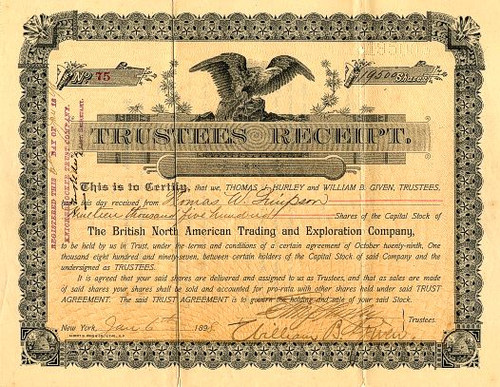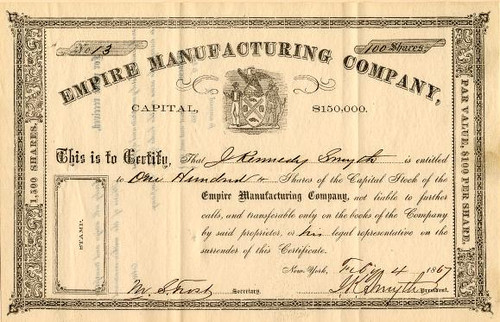Beautifully engraved specimen certificate from the American and British Manufacturing Corporation printed around 1910. This historic document was printed by American Bank Note and has an ornate border around it with a vignette of American and British flags. 
Certificate Vignette A Corliss Steam Engine is a steam engine fitted with Corliss valves, named after the American engineer George Henry Corliss. There are four valves for each cylinder, with steam and exhaust valves located at each end. The Corliss Steam Engine Company was originally known as Fairbanks, Clark & Co. in the 1830s. In 1843 it was renamed Fairbanks, Bancroft & Co. when Edward Bancroft joined the company. In 1846 it was renamed Bancroft, Nightingale & Co. when George Henry Corliss joined the company, and in 1847 it was renamed Corliss, Nightingale and Co. In 1848 the company moved to the Charles Street Railroad Crossing in Providence, Rhode Island. In 1857 the company was renamed for the last time to Corliss Steam Engine Company. By 1864 George Henry Corliss bought out his partners and was the sole owner of the company. In 1900 the Corliss Steam Engine Company was purchased by the International Power Company. In 1905 it was purchased by the American and British Manufacturing Company. In 1925 the company merged into Franklin Machine Company. By then Franklin Machine Company already owned the William A. Harris Steam Engine Company. The Corliss Steam Engine Company was originally known as Fairbanks, Clark & Co. in the 1830s. In 1843 it was renamed Fairbanks, Bancroft & Co. when Edward Bancroft joined the company. In 1846 it was renamed Bancroft, Nightingale & Co. when George H. Corliss joined the company, and in 1847 it was renamed Corliss, Nightingale and Co. In 1848 the company moved to the Charles Street Railroad Crossing in Providence, Rhode Island. In 1857 the company was renamed for the last time to Corliss Steam Engine Company. By 1864 Corliss bought out his partners and was the sole owner of the company. In 1900 the Corliss Steam Engine Company was purchased by the International Power Company. In 1905 it was purchased by the American and British Manufacturing Company. In 1925 the company merged into Franklin Machine Company. By then Franklin Machine Company was already owned by the William A. Harris Steam Engine Company. Corliss' key patent expired in 1870, and after that date, numerous other companies began to manufacture Corliss engines. Among them, the William A. Harris Steam Engine Company, the Worthington Pump and Machinery Company [2], and Allis-Chalmers. In general, these machines were referred to as Corliss engines regardless of who made them. The Corliss Centennial Engine was an all-inclusive, specially built-steam engine that powered virtually all of the exhibits at the Centennial Exposition in Philadelphia in 1876. Switched on by President Ulysses Grant and Emperor Dom Pedro of Brazil, the engine was publicly visible for the duration of the fair. At 45 feet tall and with a flywheel 30 feet in diameter, the Centennial Engine produced 1,400 horsepower. After the fair, it was disassembled and shipped back to Corliss's plant in Providence. Seven years later it was sold and powered a Chicago factory owned by George Pullman until 1910. This engine became a cultural icon, so much so that, to many modern historians, the term Corliss engine refers to this specific engine and not to the broad class of engines fitted with Corliss valve gear. History from Wikipedia and OldCompanyResearch.com (old stock certificate research service).
About Specimens Specimen Certificates are actual certificates that have never been issued. They were usually kept by the printers in their permanent archives as their only example of a particular certificate. Sometimes you will see a hand stamp on the certificate that says "Do not remove from file". Specimens were also used to show prospective clients different types of certificate designs that were available. Specimen certificates are usually much scarcer than issued certificates. In fact, many times they are the only way to get a certificate for a particular company because the issued certificates were redeemed and destroyed. In a few instances, Specimen certificates we made for a company but were never used because a different design was chosen by the company. These certificates are normally stamped "Specimen" or they have small holes spelling the word specimen. Most of the time they don't have a serial number, or they have a serial number of 00000. This is an exciting sector of the hobby that grown in popularity and realized nice appreciation in value over the past several years.

Certificate Vignette
About Specimens Specimen Certificates are actual certificates that have never been issued. They were usually kept by the printers in their permanent archives as their only example of a particular certificate. Sometimes you will see a hand stamp on the certificate that says "Do not remove from file". Specimens were also used to show prospective clients different types of certificate designs that were available. Specimen certificates are usually much scarcer than issued certificates. In fact, many times they are the only way to get a certificate for a particular company because the issued certificates were redeemed and destroyed. In a few instances, Specimen certificates we made for a company but were never used because a different design was chosen by the company. These certificates are normally stamped "Specimen" or they have small holes spelling the word specimen. Most of the time they don't have a serial number, or they have a serial number of 00000. This is an exciting sector of the hobby that grown in popularity and realized nice appreciation in value over the past several years.








